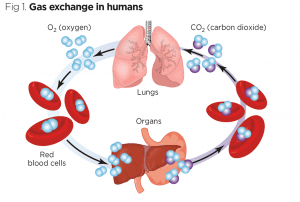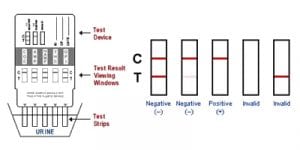Hey everyone! Today’s focus is the final two weeks of my Chemistry rotation, which was spent on the ‘manual’ bench. It was more of a miscellaneous bench, really, with testing ranging from urine drug screens, to blood gases, to hemoglobin A1cs. I suppose microscopic urinalysis and point-of-care testing (POCT) are more visual and/or hands-on than putting samples on an analyzer, but technology was still an integral part of the workflow.
Anywho, I digress. A few of the more interesting tests performed on this bench:
Arterial blood gas (ABG) – The transport of carbon dioxide and oxygen via red blood cells plays an important role in the body’s regulatory mechanisms, and so ABG analysis measures the amounts of these gases in the blood.

As one might infer, imbalances in the blood’s oxygen, carbon dioxide, and pH levels may indicate less-than-optimal lung function. Blood gases are almost always ordered as a STAT test (results available within 60 minutes)—not only because their results can influence timely treatment, but because the analytes are falsely increased/decreased with delayed testing.
In a whole blood sample, white blood cells will continue cellular metabolism outside the body: O2 is consumed, CO2 is produced, and pH is decreased. It goes without saying, but these results would no longer be an accurate representation of patients’ status.
Be the first to receive the latest BCIT News. Become a subscriber.
Point-of-care testing (POCT) – By definition, POCT is testing which can be performed outside of the lab, and by non-lab personnel. The devices are simplified and often quite portable, like the urine drug test kit pictured below.

Though POCT devices are designed for use outside the centralized lab, techs in Kelowna still handle several rapid analyses including fecal occult blood (hidden blood in the stool) and urine drug testing.
As the devices are read visually, and discarded after entering the results into the laboratory information system (LIS) by hand, there is definitely added responsibility in keying in the correct results and interpreting them at the appropriate time. Test procedures say when you are to interpret results (e.g. 1 min. after adding reagent); permitting over/under development of the signal can give false positives or negatives.
Speaking in metaphor, lab techs become the interface between the LIS and the ‘analyzer’—I triple-checked my typing before verifying anything!
Urinalysis – I could write an entire blog post on urinalysis. I’m not going to, but I could—we covered a lot of theory and looked at a lot of urine under the microscopes at BCIT.
One thing I have a better understanding of following my rotation in Chemistry is when a patient’s macroscopic analysis warrants microscopic examination. At BCIT, we performed macroscopic and microscopic analysis on every sample – mainly for the practice, but it should be stressed that in a clinical setting, microscopic examination is not necessarily part of routine urinalysis.
Macroscopic urinalysis looks at the physical and chemical properties of the sample. What colour is the urine? How clear or turbid is it? A urine test strip is then dipped into the sample and read either visually or by an automated instrument.

On the left of the image is a typical urine test strip; each pad contains different chemicals, which change colour based on the urine’s composition. There are pads for clinically significant constituents including blood, leukocytes (white blood cells), and nitrites.
Microscopic examination can be specifically ordered by a physician, or reflex ordered based on the macroscopic results. The presence of nitrites in urine is often indicative of a urinary tract infection, as certain bacteria have the ability to convert nitrates (found naturally in some vegetables) to nitrites. For this reason, macroscopic results can also reflex order a urine culture to be done in Microbiology.
If the macroscopic shows all normal or negative indices, microscopic examination is often not needed; the likelihood of seeing cells and other elements of clinical significance is rather slim.
And did I mention urine smells?
It’s hard to believe I am almost halfway through my practicum… it’s been a lot of stress, coffee, and invaluable experience.
Learn more about the Medical Laboratory Science full-time diploma program at BCIT.
